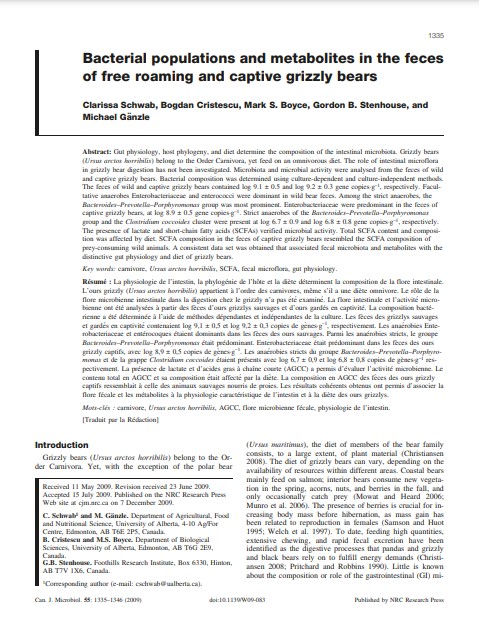Bacterial populations and metabolites in the feces of free roaming and captive grizzly bears
Bosque Modelo:
Foothills
Temática:
Gestión forestal
Tipo de documento:
Artículo científico
Resumen
Gut physiology, host phylogeny, and diet determine the composition of the intestinal microbiota. Grizzly bears (Ursus arctos horribilis) belong to the Order Carnivora, yet feed on an omnivorous diet. The role of intestinal microflora in grizzly bear digestion has not been investigated. Microbiota and microbial activity were analysed from the feces of wild and captive grizzly bears. Bacterial composition was determined using culture-dependent and culture-independent methods. The feces of wild and captive grizzly bears contained log 9.1 ± 0.5 and log 9.2 ± 0.3 gene copiesg–1, respectively. Facultative anaerobes Enterobacteriaceae and enterococci were dominant in wild bear feces. Among the strict anaerobes, the Bacteroides–Prevotella–Porphyromonas group was most prominent. Enterobacteriaceae were predominant in the feces of captive grizzly bears, at log 8.9 ± 0.5 gene copiesg–1. Strict anaerobes of the Bacteroides–Prevotella–Porphyromonas group and the Clostridium coccoides cluster were present at log 6.7 ± 0.9 and log 6.8 ± 0.8 gene copiesg–1, respectively. The presence of lactate and short-chain fatty acids (SCFAs) verified microbial activity. Total SCFA content and composition was affected by diet. SCFA composition in the feces of captive grizzly bears resembled the SCFA composition of prey-consuming wild animals. A consistent data set was obtained that associated fecal microbiota and metabolites with the distinctive gut physiology and diet of grizzly bears.
Información Bibliográfica
Autor:
Schwab, C., Cristescu, B., Boyce, M.S., Stenhouse, G.B., Gänzle, M.
Revista:
Canadian Journal of Microbiology
Año:
2009
N°:
-
País :
Canadá
Páginas:
1335 - 1346
Volumen:
55
Idioma:
Ingles
Palabras claves
carnivore, Ursus arctos horribilis, SCFA, fecal microflora, gut physiology





